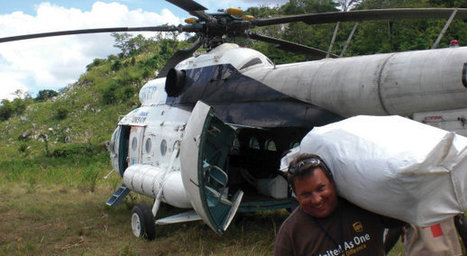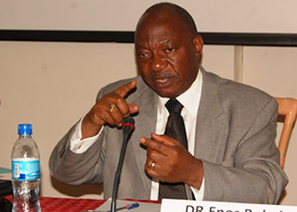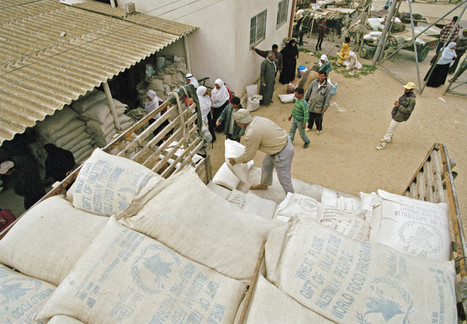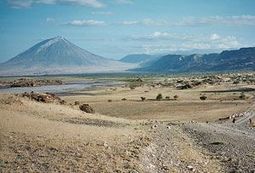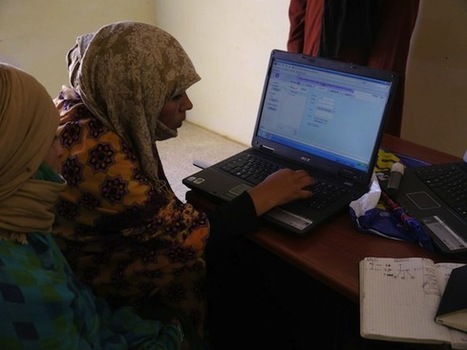 Your new post is loading...
 Your new post is loading...

|
Scooped by
Robin Landis
August 7, 2013 8:31 AM
|
The World Bank has agreed to finance the construction of a key road linking Kenya and South Sudan to boost trade and investment between the two countries... ...The Kenya National Highways Authority (KeNHA) said the road, which links Kenya’s northwestern town of Lodwar and Nadapal, a town just inside South Sudan on the Kenyan border, is part of the South Sudan-East Africa Regional Transport and Trade Facilitation Program (SS-EARTTFP). The Lodwar-Nadapal Road belongs to a larger 595 km project linking Kenya’s northern town of Eldoret and Nadapal, which will be upgraded to “Paved Road status in a bid to speed up movement of goods and services between Kenya and South Sudan,” [KeNHA] ...Meanwhile, final designs of a great Northern Corridor are expected to be submitted to the World Bank by September. Cost estimates will be determined once the designs are complete. The corridor is expected to run from Eldoret, through the border post of Nadapal, all the way to Juba, capital of South Sudan. Already, work for the 340 km section between Juba and Nadapal has commenced, with the World Bank providing the funding.

|
Scooped by
Robin Landis
August 7, 2013 8:22 AM
|
...For this critical Agricultural green plan to work successfully, several factors must be in place and these must work towards the whole plan and contribute towards achieving the said growth plans. None of those is more crucial than regional inter and intra East African and African trade. For a long time, Africans worked and pushed their co-operation agenda based on the cobwebs of colonial linkages that were never quite broken 50 years ago. East Africans, for instance, did more work protecting their borders from regional trade than ensuring that food, a necessary life support requirement across borders. If and when the SAGCOT project works, Tanzania will immediately have in abundance not just maize, but green vegetables, beans, yams, potatoes, rice, wheat and avocados. While Europe continues to dilly dally over what they can buy from Africa and the United States puts limits on what products from this region can access their markets, East Africa can use its production increase to ensure food access to its 90 million plus people. What is more important than making food available to a population? However, to make sure that Avocados from Mbeya can get to markets in Kakuma on the border of Uganda and Southern Sudan, infrastructure will have to be put in place....

|
Scooped by
Robin Landis
August 7, 2013 4:50 AM
|
[INDONESIA] The United Nations World Food Programme (WFP) in partnership with the National Disaster Management Agency (BNPB) are today presenting the findings of a joint logistics capacity assessment carried out in NTT, NTB and Bali Province, as part of efforts to further strengthen Indonesia’s emergency response mechanisms. The assessment, conducted in May and June of this year, provides data supporting the location of a regional emergency response hub (Unit Pelaksana Teknis/UPT) in Kupang, as part of a network of such hubs across Indonesia. The hubs will be located in six strategic positions chosen for their proximity to disaster-prone areas, as well as the presence of vital logistics infrastructure, such as roads, gateways and warehouses.

|
Scooped by
Robin Landis
August 7, 2013 4:35 AM
|
...In the absence of an efficient in-house supply chain process, third-party logistics providers, like UPS, can offer a myriad of resources and solutions to help government organisations and NGOs serve their people and each other, similar to what was carried out for the United Nations High Council on Refugees (UNHCR), which oversees all UN-sponsored refugee camps. Each camp that the UN manages, including those with half a million people, is currently using paper-based systems to track all food and non-food items (NFIs). Teams at UPS have been working to increase efficiency by developing software compatible with tablets that can scan bar-coded family IDs of camp residents to ensure equitable and proper distribution. Additionally, organisations should focus on collaborating with one another to achieve common technology goals. For example, a small NGO could leverage what advanced NGOs and relief agencies have in place instead of having the shared third party invest in the same solution, separately, for the different organisations. This type of lateral, open communication improves efficiency and saves costs...

|
Scooped by
Robin Landis
August 6, 2013 10:13 AM
|
From an interview with Brett Hanley, Head of Sub-Office, Gambella, WFP Ethiopia ..."In 2012, Canada was the second largest donor to Ethiopia having contributed over 46 million USD to programmes in the country, providing food assistance to more than 6 million vulnerable people, including refugees and school children. Of particular note, Canada has generously supported the construction of the Humanitarian Logistics Base in Djibouti, as the Djibouti Port is the main gateway for food entering Ethiopia."

|
Scooped by
Robin Landis
August 6, 2013 10:04 AM
|
Over the past decade, the global life sciences sector has experienced a tremendous growth...The global market for pharmaceuticals, for example, has doubled within a decade...[and]...is particularly relevant in Africa, which is positioned as the next frontier for the healthcare sector.... The life sciences logistics model in Africa is therefore changing drastically as, in the last two and a half years, we have seen major growth in hubs like Kenya, servicing East Africa and South Africa, which plays a key role for the Southern African Development Community countries; in addition to direct shipments into specific countries, as the capabilities grow within the region.

|
Scooped by
Robin Landis
August 6, 2013 9:56 AM
|
Poor railway connectivity and the costly destruction of adjoining roads by overloaded trucks has raised the cost of transport along the two main East African corridors (Central and Northern) to some of the highest per ton transport costs in the world... As the major ports of Dar es Salaam and Mombasa strain under exponentially growing trade, the East African Community (EAC) is turning its eyes to the proposed 53trn/- port of Mwambani in Tanga to meet the capacity shortfall... ...The Mwambani Port and Railway Corridor will not only provide a land bridge from the Indian Ocean Port of Mwambani to landlocked states but will also open up vast land areas that currently lay idle, it will improve connectivity and usher in new areas for development in agriculture and mining across its path.

|
Scooped by
Robin Landis
July 19, 2013 10:44 AM
|
The United Nations and its humanitarian partners in South Sudan have for the first time this year gained access to areas in Pibor County where thousands of people have been stranded in the swampy bush... “Non-governmental organisations (NGOs) and UN agencies have met communities near Dorain, Fertait and Labrab to assess their needs and mount a humanitarian response,” UN Humanitarian Coordinator in the country, Toby Lanzer said in a statement. The response includes urgently needed medical attention, in addition to ongoing programmes in other parts of Jonglei State. With the rainy season started and expected to last through December, the basic concerns of the families in the area are staying dry and warm, food and medical needs.

|
Scooped by
Robin Landis
July 5, 2013 1:52 AM
|
The Secretary-General hailed the new complex as an important contribution to a more efficient, carbon neutral UN. “From the rows of parked bicycles to the wind turbines out to sea, I see proof that we can tackle the climate challenges that face us...From solar panels to seawater cooling and external metal blinds to regulate light and heat, UN City shows what can be achieved. Estimated energy consumption will be cut by more than half.” [UN Secretary-General Ban Ki-moon] The concept of a more efficient and coherent UN was first strongly underlined in the Millennium Declaration, adopted by world leaders in 2000. The Danish Government, wishing to lend its support in practical terms to the idea, decided soon afterwards to investigate the possibilities of moving eight Copenhagen-based UN agencies into one single compound. The eight agencies that will share the new high-tech premises are the: UN Development Programme (UNDP); UN Environment Programme (UNEP); UN Office for Project Service (UNOPS); World Food Programme (WFP); UN Entity for Gender Equality and the Empowerment of Women (UN-Women); and World Health Organization (WHO).

|
Scooped by
Robin Landis
July 4, 2013 10:52 AM
|
A recent Work Bank study demonstrates that the average cargo dwell time in most Sub-Saharan African ports is close to 20 days as compared to the average 4 days dwell time encountered in most large East Asian or European ports. Although Africa is poised to be one of the most strategic partners for trade and best bets for infrastructure investment in the 21st century, ports in sub-Saharan Africa still rank inefficient by global standards and lack sufficient capacity to meet growing cargo volumes forecast to arrive on Africa’s shores over the medium term.... ...Chief Executives from over 8 African ports are setting the pace for maritime expansion by sharing their expansion strategies and expertise, playing a more pivotal role than ever in the continent’s growth... ...Challenges such as insufficient container storage space, long container dwell time, rapid increase in cargo volumes leading to port congestion, low performance of inland modes of transport, and lack of ability to acquire more space for port activities are mobilising the industry to start planning today for Africa’s ports of tomorrow.

|
Scooped by
Robin Landis
July 3, 2013 2:13 AM
|
Mobile populations face the severe challenge of accessing services at appropriate locations and times. Targeted HIV services for the transport corridors are poorly coordinated, inadequately resourced, operate under out-dated policies, and experience severe structural barriers such as infrastructure, service availability and accessibility that limit the appropriate provision of services or inhibit proper access of the key population... ...The National Strategy on HIV/AIDS and STI (sexually transmitted infection) Programming along Transport Corridors in Kenya - developed by the International Organization for Migration (IOM), the UN Joint Programme on HIV/AIDS in Kenya and the National AIDS Control Council - aims to consolidate and streamline efforts to improve the prevention and control of HIV along the country’s transport corridors...

|
Scooped by
Robin Landis
July 2, 2013 11:11 AM
|
When you think of the logistics of humanitarian aid there is no better United Nations agency in the world that documents, shares, and reports on the remarkable work they do than the World Food Programme (WFP). With a separate department devoted entirely to logistics, the WFP shares multiple ways in which they deliver food aid to those who desperately need it. The WFP recently released its first annual logistics report that provides minute details about the air, sea, and surface transport used to deliver food as well as the cost-cutting measures they are taking to ensure monies that can be used for food aid is not frivolously spent on transport. For logistics geeks, the annual report is an eye-opening look into the way humanitarian food – most of which goes to Africa – is moved through the world. It is not easy nor is it inexpensive. In fact, the average cost to transport food is $100 per metric ton for sea delivery, $180 per metric ton per land delivery, and a whopping $3500 per metric ton for air drops. The World Food Programme’s logistics budget for 2012 was $986 million reaching 70 countries according to the report. With such a massive workload of global humanitarian food distribution the World Food Programme is also tightening the way in which it monitors the food it provides to hungry populations. With a new system called LESS, the World Food Programme will be able to monitor all of its commodities online in one single system. “LESS has empowered WFP country offices in Liberia and Sierra Leone, and their remote sub-offices and warehouses, with real-time supply chain management and commodity reporting capabilities. As two post-conflict countries, they are not the simplest places to deploy high-tech solutions, reaching far beyond the capitals. LESS accurately accounts for every kilogram of food; it records supply chain transactions all the way to the
beneficiaries’ own neighbourhoods. Extending this powerful capability throughout WFP will dramatically boost our efficiency and accountability,” said Ertharin Cousin, Executive Director, WFP. The report also lays out the country donors that collectively provided $177 million to WFP Special Operations in 2012. The European Union donated the most with the United States coming in third place in donor monies. Additionally the private sector has donated to the humanitarian efforts including Caterpillar, PepsiCo, UPS, and Renault Trucks. Visit the World Food Programme Logistics to learn more at www.wfp.org/logistics.

|
Scooped by
Robin Landis
June 27, 2013 2:32 AM
|
According to a recent study, Rwandan road haulage firms have steadily lost market share against its neighbours over the past five years despite an increase in trade volumes within the East African Community (EAC). The report, named ‘Rwanda’s Road Freight Industry Competitiveness Study’ commissioned by the Ministry of Trade and Industry with support from TradeMark East Africa, attributes high road tolls in neighbouring countries, especially Tanzania, as the main reason why the local trucking industry has seen a decline in its share of the road freight market... Theodore Murenzi, the Secretary General of Rwanda Truckers’ Association, said: “Rwandan truckers must pay US$500 per trip to the Dar es Salaam Port in contrast to Tanzanian firms that pay only US$152. The Northern corridor differences (with Kenya and Uganda) are also unfavourable but to a much lesser extent. This is the main problem that faces Rwandan road freight industry which will be dealt with through carefully negotiations within the EAC [East African Community].”
|

|
Scooped by
Robin Landis
August 7, 2013 8:25 AM
|
...The single customs territory for EAC ensures taxes are collected from first point of entry. Therefore, it will allow Uganda and Rwanda to position customs officers at the Mombasa Port...the deal will make the Northern Corridor (Mombasa-Malaba-Kampala-Kigali) one region for custom purposes...under the arrangement, customs officials from Rwanda and Uganda will assess taxes at Mombasa, but importers will pay the taxes from their respective countries.... The business community will also be able to use one insurance bond for East Africa to cover all transactions.With the single customs territory, time and the cost of cargo clearance will be reduced, in addition to removal of non-tariff barriers (NTBs), like roadblocks and weighbridges, along the corridor, which is good for business. Traders will be able to save the money they have been spending on NTBs... ...According to a study by the World Bank, Doing Business in East African Community 2013, increasing customs efficiency can boost trade volumes. In sub-Saharan Africa an inefficient trade environment was found to be among the main factors in poor trade performance. The study found that a one-day reduction in inland travel times leads to a 7 per cent increase in exports. It indicates that improvements in transport efficiency and the business environment have a greater marginal effect on exports in lower income economies than in high-income ones.

|
Scooped by
Robin Landis
August 7, 2013 8:10 AM
|
Kenyan police roadblocks have been the single-biggest impediment to overland cargo movement from the Port of Mombasa to Uganda, Rwanda, Burundi and eastern DR Congo. Importers and transporters have welcomed the removal of the roadblocks, as they have for decades borne the cost of roadblocks in both time and bribes... ...Governments too, lose millions of dollars each day in revenues to bribes and unnecessary delays. According to figures available from the Transit Transport Co-ordination Authority of the Northern Corridor, businesses lose $800 USD per day per truck due to delays alone while governments lose $57,730 in tax revenue to bribes per 100 transactions... ...With 25 police checkpoints, 15 roadblocks and 13 weighbridges between Mombasa and Gatuna, there are still many barriers for transporters to deal with. Cumbersome and confusing paperwork at the borders is another cause of unnecessary delays and can provide an avenue for corruption. While Rwanda has moved a step ahead by introducing a single window through which all import documentation can be handled, in neighboring countries importers still have to move between several offices to have goods cleared... ...Fortunately, Kenya has also taken measures to streamline operations at the Port of Mombasa. For example, authorized clearing and forwarding service companies and commercial banks have been ordered to operate on a 24-hour basis or have their licenses cancelled. This means that importers will no longer have to wait for the next day to pay their fees... ...only two modernized weighbridges will remain at Mariakani and Athi River. Moreover, trucks weighed at Mariakani with seals intact will be allowed to proceed to Malaba without further inspection at police roadblocks or other weighbridges. Kenya also has a 5% overloading allowance...

|
Scooped by
Robin Landis
August 7, 2013 4:40 AM
|
According to Mark Priestley, the TradeMark East Africa country director, the main objective of integration is to promote regional trade. "Eliminating non-trade barriers and implementing the single widow system will make trade faster and cost effective," he noted. Currently, it takes between eight and 10 days to clear cargo at the Port of Mombasa, while clearance at border points takes a minimum of two days. Freight handling at airports takes three days. But automation could drastically reduce these periods by up to 70 per cent, according to experts.

|
Scooped by
Robin Landis
August 6, 2013 10:21 AM
|
Tanzania signed a $210-million (340-billion shilling) loan agreement with the World Bank's International Development Association (IDA) Monday (July 29th) to make improvements to the country's physical infrastructure in line with the Southern Africa Trade and Transport Project. The money will be mainly used for upgrading and rehabilitating the 140-kilometre Mafinga-Igawa highway...Funds will also go towards creating a one-stop border crossing centre at the Songwe-Kasumulu border post and improving road safety and traffic conditions.

|
Scooped by
Robin Landis
August 6, 2013 10:08 AM
|
Tanzania signed a $210-million (340-billion shilling) loan agreement with the World Bank's International Development Association (IDA) to make improvements to the country's physical infrastructure in line with the Southern Africa Trade and Transport Project...The money will be mainly used for upgrading and rehabilitating the 140-kilometre Mafinga-Igawa highway. Funds will also go towards creating a one-stop border crossing centre at the Songwe-Kasumulu border post and improving road safety and traffic conditions. "This support has come at a time when the government is in a critical need of implementing interventions to facilitate the movement of goods and people along the North-South Corridor to enable Tanzania to become the transport and logistics hub for neighbouring countries".

|
Scooped by
Robin Landis
August 6, 2013 9:59 AM
|
The Zambia Railways Limited, Societe Nationale De Fer Du Congo Sarl of the Democratic Republic of Congo and Tanzania Zambia Railways, jointly owned by the Zambian and Tanzanian governments, have signed a tripartite agreement after holding a consultative meeting to iron out the challenges and the way forward.

|
Scooped by
Robin Landis
August 6, 2013 9:54 AM
|
...A [recent] UN report says that efforts to date to spur jointly reinforcing economic growth on the continent have relied on a “textbook” and “linear” approach to regional cooperation that does not fit with the situation in Africa, world’s second-largest and second-most-populous continent with than one billion people. What is required is a “21st century approach to dealing with 21st century challenges”, stresses The Economic Development in Africa Report 2013, subtitled Intra-African Trade Unlocking Private Sector Dynamism. The report released by the UN Conference on Trade and Development (UNCTAD) on July 11, 2013 asks African countries to adopt a new approach to regional integration, referred to as “developmental regionalism”. Developmental regionalism encompasses cooperation among countries in a broader range of areas than just trade and trade facilitation, to include – for example – investment, research and development, as well as policies aimed at accelerating regional industrial development and regional infrastructure provision, such as the building of better networks of roads and railways... ...Selling in nearby markets gives firms cost advantages through proximity, potentially reduced transport expenses, better knowledge that allows goods to be fitted to local conditions, and, if sufficient customers can be found, enough critical mass to justify expanding industry...

|
Scooped by
Robin Landis
July 19, 2013 10:40 AM
|
The Kenya section of the existing gravel road runs from the border at Taveta to Voi through Mwatate linking with Mombasa. The components of this project include design review and supervision, road side amenities, support to road safety initiatives and trade facilitation... The completion of the two roads, by 2018, will increase trade between the Kenya and Tanzania... The Arusha-Holili/Taveta-Voi road is one of the transport corridors of the East African Region meant to reduce the cost of doing business, increase competitiveness of the region on the global market and at the same time promote integration. The corridor, at completion will link the port of Mombasa to northern and north-western Tanzania and the landlocked countries including Rwanda, Burundi, Democratic Republic of Congo and Uganda, providing an alternative route to the sea.

|
Scooped by
Robin Landis
July 5, 2013 1:49 AM
|
"Somalia has become the target of Iranian own logistics companies to make quick money by establishing small logistics company in the neighboring countries, these companies are often given UN and EU cargo shipments because they are claiming to be Somalia logistics expert."...

|
Scooped by
Robin Landis
July 3, 2013 2:17 AM
|
The High Court has temporarily halted President Kenyatta's executive order to kick out transit sheds within the Mombasa port. The companies handling customed cargo were to be kicked out yesterday after the Kenya Revenue Authority issued notice to withdraw custom officers from the premises. Mombasa Resident Judge Maureen Odero who heard the exparte application granted separate leave to the two companies. The court ruled the grant of leave would also serve as a stay order against the move by KRA to either suspend the company from handling customed cargo or withdraw its officers. Removal of the officers would have halted operations at the facility since it would have led to an automatic deactivation and barring of CAMIS passwords linked to the KRA's IT systems. The President had ordered the Kenya Ports Authority to eject transit sheds and clearing and forwarding service companies at East Africa's largest port to ease congestion.

|
Scooped by
Robin Landis
July 3, 2013 2:10 AM
|
This IT disaster management software, helps to determine conditions related to weather, infrastructure, geo-political events, disasters, and crime. Companies that have a global manufacturing base with multiple locations and suppliers find it difficult to track potential disruptions to their supply chain on a daily basis.

|
Scooped by
Robin Landis
June 27, 2013 5:18 AM
|
Communication between beneficiaries and food aid providers in the Western Sahara refugee camps in Algeria suffers as the number of food distribution points increases. Rosa Akbari worked as an independent researcher funded by a grant from the United Nations Office for the Coordination of Humanitarian Affairs (UNOCHA) to explore better communication tools to be used within the camps. What she found was a society prepped for technological innovation. By using what was already in place – a mobile phone in each household – Rosa capitalized on existing flows of information as they worked without technology and used FrontlineSMS to ease the communication within the camps... In 2010, the Sahrawi Red Crescent (SRC) – the lead humanitarian coordination agency in the camps – managed 27 food distribution points for nearly 125,000 people. They have since expanded to 116 distribution points: one per neighborhood. This made distribution logistics and staff coordination complex. Internal communication was unreliable at best and non-existent at worst, and beneficiaries wanted to know more from humanitarian leaders. As a result, my efforts evolved from technological experimentation to practical implementation using a text messaging (SMS) platform called FrontlineSMS...
|



 Your new post is loading...
Your new post is loading...



